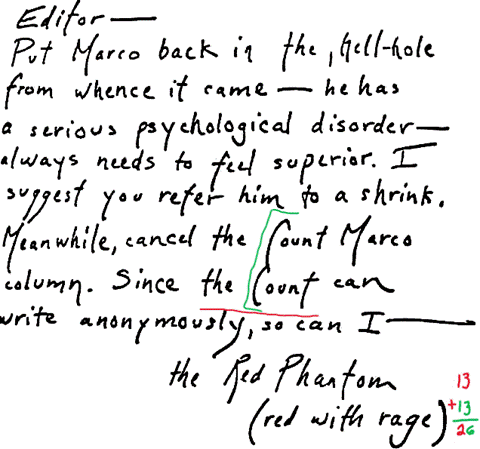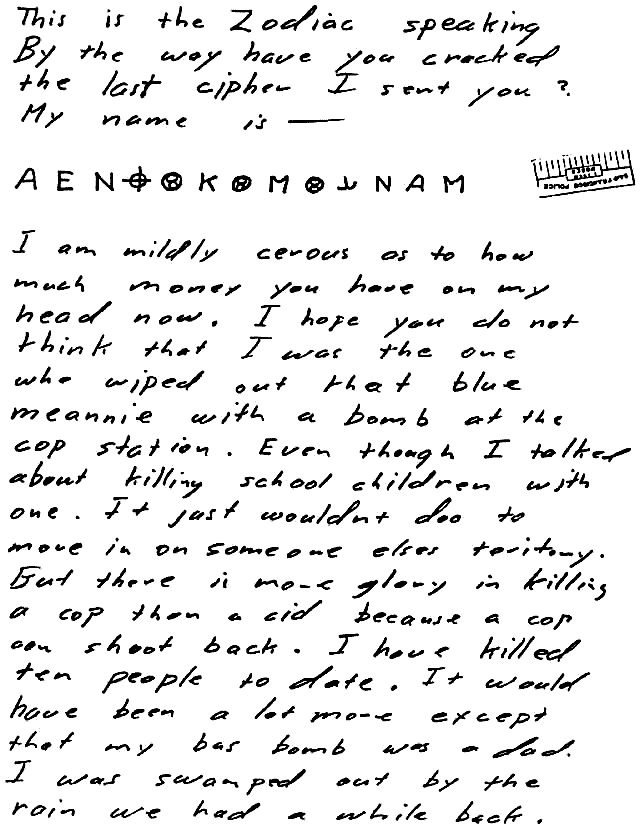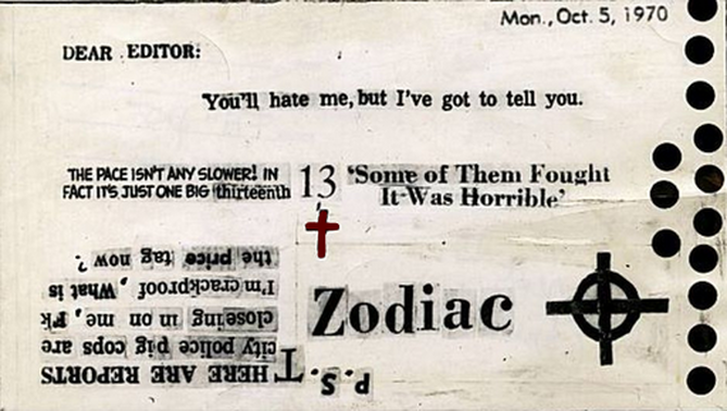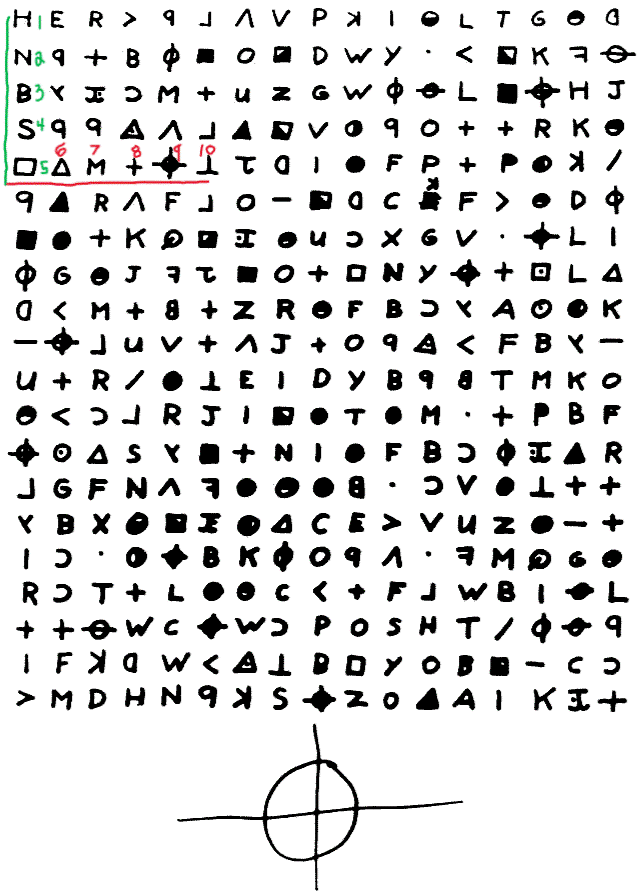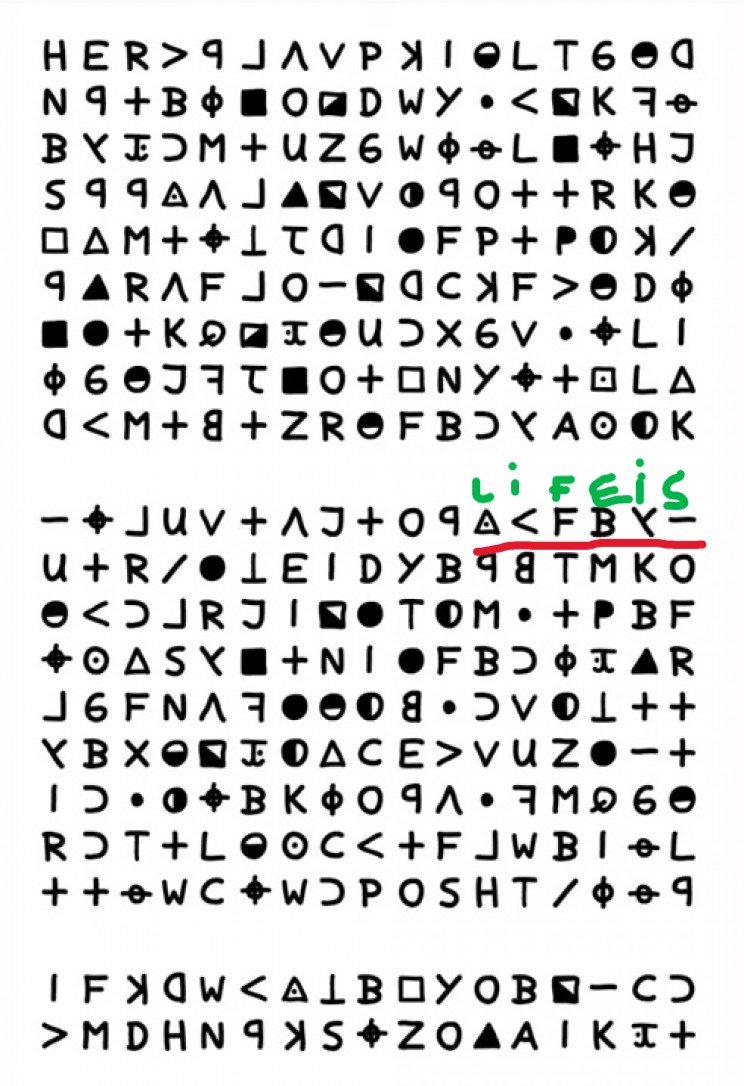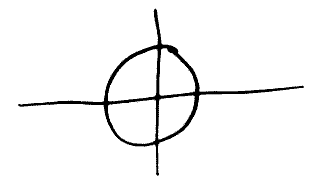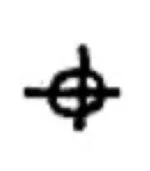The “My name is” Cipher
Blog Post #7
The “My name is” cipher is said to be unsolvable; its thirteen characters are supposed to be too few to establish patterns. But as it appears in a letter within a larger set of letters, the cipher does not take place in a vacuum—and patterns can be established in all sorts of ways.
In each of the images above, a long and/or blank line is involved with an unknown person—and all three Unknown Person Lines come from letters purportedly written by the Zodiac Killer.
As explained in Blog Post #1, “THE CONFESSION” letter seems to be symbolically initialed with Z because its “CC” section is a total of twenty-six characters (counting punctuation but not the spaces between the words), and the twenty-sixth letter of the alphabet is Z as in Zodiac. In other words, THE CONFESSION’s CC section works as a Hidden Z Initial.
In the same vein, the Red Phantom Letter’s signature is a total of twenty-six characters (again, counting punctuation but not the spaces between the words). The signature is also two lines—just like THE CONFESSION letter’s CC section. And so, both letters seem to have a Hidden Z Initial (in addition to an Unknown Person Line).
The Red Phantom Letter gives two huge clues as to the importance of its signature’s character count: 1) its own subject matter—specifically, “the Count” (as underlined with red in the first image up), and 2) its Overlapping Cs (beside the green bracket); conspicuous for being the document’s only touching letters, the Overlapping Cs work as an allusion to THE CONFESSION letter’s CC section (which is twenty-six total characters just like The “Red Phantom” Letter’s signature). . . . And so, it is fair to assume that the Overlapping Cs and “CC.” from THE CONFESSION letter stand for Character Count.
As explained in Blog Post #4, THE CONFESSION is the first letter the Zodiac Killer mailed out, while the Red Phantom Letter is the last. And so, their many thematic connections are a case of the Zodiac Killer’s coming full circle. . . . As also explained in Blog Post #4, there are a total of twenty-six letters mailed out by the Zodiac Killer—and all together, they work as a pun: 26 Letters in the Mail = 26 Letters in the Alphabet. And so, THE CONFESSION and the Red Phantom Letter begin and end the overarching allusion to the Zodiac Killer’s alphabet-number code (which assigns a number to every letter based on its position in the alphabet—A-1, B-2, C-3, etc.).
This Theme of 26 shows up time and time again in the Zodiac Killer case (as explained throughout this website). In other words, it’s a pattern.
Unscrambled Solution: RossOSullivan
The apostrophe [‘] in O’Sullivan is left out. In other words, punctuation is left out of the My Name Is solution—just like the z340 and z408 solutions.
Sequence Rules
I. As in the multiple-row z340 and z408 ciphers, the first symbol represents the first letter.
II. Jump (as in taking a piece in checkers [but unlike the board game, any jumped piece in the cipher remains in play]) the symbol to the right and land on the symbol for the next letter. . . . Going to the right will be known as a forward turn. There are also Special Backwards Turns, but the majority of turns go forward.
III. After every three forward turns (whether or not they are broken up by a Special Backwards Turn), add a jump for each forward turn thereafter (like in checkers when taking multiple pieces at once [but again, the jumped symbols in the cipher remain in play]). In other words, after the first three forward turns, do double jumps as the standard for forward turns—then after three forward turns with double jumps, do triple jumps as the standard for forward turns. The cipher ends before a quadruple-jump would be required.
IV. Because the first symbol represents the first letter, no jumps are required to reach it—therefore, it does not count as a turn.
V. Likely referencing how five of the thirteen symbols are images (one Cross-and-Circle symbol, three Eight Balls, and one Asymmetric Anchor), while eight of the thirteen symbols are letters—the fifth and eighth turns are Special Backwards Turns of a single jump each. And while that special feature makes the cipher more difficult to solve, it constitutes a Five-and-Eight theme that adds credibility to the RossOSullivan solution.
VI. Ignore already used symbols. And always ignore the twelfth symbol, because it represents its own letter A.
VII. Go around the world whenever there are no available symbols to land on.
By the way, jumping and going around the world are both part of the sequence for the multiple-row z340 cipher (even though the ideas aren’t necessarily given labels by the cryptologists who solved it [David Oranchak, Sam Blake, and Jarl Van Eycke]). To see for yourself, check out the YouTube video at this web address: https://www.youtube.com/watch?v=-1oQLPRE21o. . . . Note: In the z340 cipher sequence, jumps are one of two steps for each turn—the other being a row change.
The far-left symbol—which is the letter A—represents the first letter in the solution to this one-row cipher. In other words, start in the most obvious place as with every solved Zodiac Killer cipher to date. . . . The logic behind why the second and only other A symbol is ignored in the sequence seems to be that the first A symbol requires no jumps and thus no turns to reach. In other words, the A symbol is always reached automatically.
Progress: RXXXXXXXXXXXX
The first turn is a single jump from the first A symbol, over the E symbol, onto the first N symbol. The second and third turns work in the same manner.
Progress after 1st turn: ROXXXXXXXXXXX
Progress after 2nd turn: ROSXXXXXXXXXX
Progress after 3rd turn: ROSSXXXXXXXXX
Because three forward turns of a single jump each have already been completed, the fourth turn is a double jump.
Progress after 4th turn: ROSSOXXXXXXXX
As already explained, the fifth and eighth turns are Special Backwards Turns of a single jump each.
Progress after 5th turn: ROSSOSXXXXXXX
The sixth turn is a double jump: Jump 1 goes from the third Eight Ball, over the Asymmetric Anchor, and lands on the second M symbol (the second N symbol is ignored because it has already been used, and the second A symbol is always ignored); jump 2 goes from the second M symbol, around the world (back to the cipher’s far-left), over the E symbol (because the first A symbol has already been used), and lands on the Cross-and-Circle symbol (because the first N symbol has already been used).
The seventh turn is the final double-jump turn. And the eighth turn is the other Special Backwards Turn of a single jump.
Progress after 6th turn: ROSSOSUXXXXXX
Progress after 7th turn: ROSSOSULXXXXX
Progress after 8th turn: ROSSOSULLXXXX
The ninth turn is a triple jump: Jump 1 goes from the first M symbol, over the Asymmetric Anchor, around the world, and lands on the E symbol; jump 2 goes from the E symbol, over the K symbol, and lands on the Asymmetric Anchor; jump 3 goes from the Asymmetric Anchor, around the world, over the E symbol, and lands on the K symbol.
Progress after 9th turn: ROSSOSULLIXXX
In addition to being the final turn in the sequence, the tenth turn is another triple jump: Jump 1 goes from the K symbol, over the Asymmetric Anchor, around the world, and lands on the E symbol; jump 2 goes from the E symbol, over the Asymmetric Anchor, around the world, and lands back on the E symbol (where the jump began); jump 3 is identical to jump 2 (and that’s why this image has only two sets of lines instead of three).
Progress after 10th and final turn: ROSSOSULLIVXX
The A symbols work as bookends for the sequence; one is used directly before the first turn, while the other is used directly after the last. . . . As it is ignored in the sequence and represents its own letter, let’s call the second A symbol the Special Second A.
Progress: ROSSOSULLIVAX
Being the final symbol, the Asymmetric Anchor doesn’t require a turn to reach. Ironically, it creates a certain symmetry in the process; anchor begins with A, and the other symbols reached without a turn are the two A symbols. In other words, A’s are “automatic” in the sequence—and that goes for the A in RossOSullivan as well (because it is represented by the Special Second A).
Finished solution: ROSSOSULLIVAN
And from what I gather, Ross Sullivan was not a publicly known Zodiac Killer suspect in 1970 when the “My name is” cipher was mailed out. In other words, the Zodiac Killer would likely have had to pluck the RossOSullivan solution out of thin air if it wasn’t his actual name or a modified version of it.
The Five-and-Eight Theme
The “My name is” cipher’s Five-and-Eight theme has many obvious pieces of evidence as listed below.
#1: The cipher has five images for symbols and eight letters for symbols.
#2: The fifth and eighth turns in the sequence are Special Backwards Turns.
#3: The RossOSullivan solution has five vowels and eight consonants.
#4: The cipher’s most common symbol is the Eight Ball; Eight Ball begins with E, which is the fifth letter of the alphabet.
#5: The first Eight Ball is the fifth symbol in the cipher.
#6: Three of the symbols are Eight Balls, and the magic number minus three equals five.
#7: The eighth symbol is the letter M, M is the thirteenth letter of the alphabet, and 13 – 8 (the alphabetical position of M minus its position as a symbol) = 5.
Unsurprisingly, the Five-and-Eight theme seems to go deeper. . . . Five and eight add up to thirteen, which is the number of characters in the “My name is” cipher. As it could have any combination of numbers that don’t arithmetically reach thirteen, the Five-and-Eight theme seems to have a Dual Role as a Theme of 13. And so, more evidence for it could be found in the “My name is” cipher’s twelfth and thirteenth symbols; the twelfth symbol is the letter A, A is the first letter of the alphabet, and 12 + 1 = 13—while the thirteenth symbol is the letter M, and M is the thirteenth letter of the alphabet.
That arguably makes three more pieces of evidence for the Five-and-Eight theme—including how five and eight add up to thirteen (the number of characters in the cipher). And below is an image of what’s called the 13-Hole Postcard.
The first image below is almost identical to one on the Zodiac Cipher’s website (I have to give the site runner[s] credit for figuring this one out first). It shows why the thirteen Holes seem to represent the thirteen symbols in the “My name is” cipher.
An eight ball is black—just like the Holes.
Three Eight Balls and ten other symbols make up the “My name is” cipher—just as three Holes are separated from ten others in the 13-Hole Postcard. . . . As shown by the arrows in the second image up, these three Holes seem to “fit” where the Eight Balls appear in the cipher.
And so, the 13-Hole Postcard’s 3 Separated Holes seemingly allude to how the Eight Ball appears three times in the “My name is” cipher to become the most common symbol.
And its Upside-Down P.S. seems to suggest that the postcard should be looked at from different perspectives.
As explained in detail, the sequence for the RossOSullivan solution includes 10 Turns and 3 Automatics. In other words, ten of the symbols are reached through turns (or jumping), while three of them are reached automatically.
(The anchor is asymmetric because its left-bottom is flat, while its right-bottom is curved. This asymmetry prevents the anchor from retaining its shape in a mirror.)
The 3 Automatic Symbols are the two A symbols and the Asymmetric Anchor. And so, “Asymmetric Anchor” may indeed be what the Zodiac Killer intended for the symbol to be called; its acronym AA is quite literally the other two Automatic Symbols. In other words, AA for Asymmetric Anchor = Two A symbols.
To make a long story short, 3 Separated Holes = 3 Automatic Symbols (as well as three Eight Balls). . . . Now let’s look at a third perspective.
The second row’s tenth Hole is partly “chopped off” and would not retain its shape in a mirror from every angle—just as the cipher’s tenth symbol is an Asymmetric Anchor that would not retain its shape in a mirror.
Above is the key to the z340 cipher. It features two anchors—one with a dot or Hole at the right side, one with a dot or Hole at the left. They both represent the letter T as in tenth (symbol/hole). Together, they illustrate an Anchor and a Hole in a Mirror. . . . Below are images of the Asymmetric Anchor and an Upside-Down T (for ten) symbol from the z340 cipher.
(This Upside-Down T has an atypical appearance compared to the others in the z340 cipher.) Resembling a broken anchor, the Upside-Down T represents the letter L—and going in an L shape (similar to the sequence), it is the z340 cipher’s tenth symbol. Moreover—in terms of alphabetical order, L is the tenth letter in the z340 solution because J and K (the tenth and eleventh letters of the alphabet) are absent as seen in the image of the key.
The first page of the “My name is” Letter features the line “I am mildly cerous [misspelling of ‘curious’] as to how much money you have on my head now.”
As a follow-up to the “how much money” line from the “My name is” Letter, “What is the price tag now?” appears in the 13-Hole Postcard; the question explicitly connects the two documents.
As the postcard’s thirteen Holes resemble the letter O, they work as a statement tantamount to “O Makes Thirteen.” In turn, they would allude to the “My name is” cipher’s RossOSullivan solution and how adding the Irish O turns Ross Sullivan into thirteen letters.
Continuing the “O Makes Thirteen” statement, “JUST ONE BIG thirteenth” could allude to how—a long time ago—the O in Irish surnames was popularly stylized as lowercase (feel free to fact check that little piece of orthography trivia) because “thirteenth” is written in lowercase unlike every other word in its section of the card. . . . Moreover, the adjectival phrase in “JUST ONE BIG thirteenth” makes “thirteenth” big as well as lowercase. And so, the entire phrase works as an allusion to how the O in O’Sullivan is capitalized nowadays but was stylized as lowercase centuries ago.
The “13” Above the Cross seems to represent the Zodiac Cross-and-Circle Signature; again, “13” likely refers to the added O in the RossOSullivan solution—and O with a cross atop it becomes the Cross-and-Circle Signature.
The Upside-Down P.S. seems to be an analogue of what I call the Bus Bomb Letter’s Bizarre PS, which will be analyzed later in this Blog Post. Spoiler alert, the two postscripts work as links in a chain between the “My name is” cipher and the z340.
Appearing in the top-right corner of the 13-Hole Postcard, “Mon., Oct. 5” fits with the Five-and-Eight theme as well as the RossOSullivan solution: M for “Mon.” is the thirteenth letter of the alphabet, while thirteen is the number of characters in the “My name is” cipher; 13 - 5 (the numeric position of M for “Mon.” minus the day of the month) = 8; and O from “Oct.” can represent the Irish O in O’Sullivan.
If the Five-and-Eight theme has a Dual Role as a Theme of 13, then it seems to continue in the 13-Hole Postcard (because its holes seem to represent the symbols in the cipher). And just within the “My name is” cipher itself, the Theme of 13/Five-and-Eight theme already has ten pieces of supporting evidence. Here are three more: 1) The pronunciation of the “My name is” cipher’s eighth symbol begins with an E sound, and E is the fifth letter of the alphabet; 2) the fifth symbol represents the third letter in the sequence, and 5 + 3 = 8; and 3) the same symbol is also an Eight Ball, and 8 - 3 (for the third represented letter in the sequence) = 5. . . . By the way, I wouldn’t have counted the last two if either one of them didn’t exist; what seems intentional is the fact that the arithmetic for the three (as the third represented letter in the sequence) works two ways to make both five and eight.
In summation, the Five-and-Eight theme is one of the biggest reasons to believe that the RossOSullivan solution is correct.
But wait. . . . Have you ever noticed that handwritten fives often end up looking like the letter S?
Accordingly, the Eight Ball represents that 5-like letter (S) in the RossOSullivan solution. . . . 5S: Even typed out they look similar.
The I/Eye am Z Connection
The RossOSullivan solution furthers the I/Eye am Z interpretation described in Blog Post #2, and vice versa. As a refresher, the Desktop Poem has a “counting problem” concerning its letter I’s because one possible letter I may instead be a slash [/] (for a closer look, see second image below). However, this problem is a moot point because of something called the O/Eye Image in the poem’s title line (for a closer look, see first image below); to make a long story short, the Desktop Poem has a total of either twenty-six letter I’s or twenty-five letter I’s plus one homophonic eye image (the O/Eye Image)—and either way, the result I = Z or I am the Zodiac (because the letter I is a homophone for the pronoun I, while Z is the twenty-sixth letter of the alphabet).
I/Eye am Z accounts for both variations (26 letter I’s or 25 letter I’s + 1 eye image)—and the RossOSullivan solution does as well; Ross Mercer Stephen Sullivan is twenty-five total letters—and restoring the Irish O would make twenty-six total letters. In other words, Ross Mercer Stephen (O’)Sullivan is both twenty-five and twenty-six letters at the same time—and because the twenty-sixth letter of the alphabet is Z, adding the Irish O symbolically turns Ross Mercer Stephen Sullivan into the Zodiac Killer. . . . This also the O/Eye Image; because eye the sensory organ is a homophone for I the pronoun, the O/Eye Image means I am O (as in O’Sullivan) in reference to the RossOSullivan solution.
The z408 and z340 Connection
Another piece of excellent evidence for the RossOSullivan solution is what I call the 408 = RossOSullivan code. . . . In hindsight, the z408 cipher’s total of 408 characters seems to foreshadow the “My name is” cipher’s RossOSullivan solution; Ross is four letters, while Sullivan is eight letters—constituting digits 4 and 8 in 408 total characters; and the digit 0 between them is visually symbolic of the original Irish O restored to Sullivan in the solution (in other words, Digit 0 = Letter O.)
In the same vein, the basic message in the z408 solution is 390 characters (the cipher’s final eighteen characters are “nonsense”)—and the number 390 also works as an allusion to the RossOSullivan solution; 390’s first two digits (3 and 9) add up to twelve, while its third digit (0) is visually symbolic of the letter O—and the RossOSullivan solution is twelve letters plus the letter O.
As the z408 cipher has an extraordinarily high number of allusions to the “My name is” cipher’s RossOSullivan solution, they are explained at length in Blog Post #8 aka The z408 cipher.
More complexly, the z340 cipher also indicates that Ross Sullivan was the Zodiac Killer—but only now that it has been solved. . . . In the words of the man who solved it, the z340 cipher has the Four “Problem Letters” O, S, V, and R; they cause several misspellings in the solution. But instead of a problem, O, S, V, and R may instead be an innovative solution: O coupled with S could represent O’Sullivan; R coupled with S could represent the initials for Ross Sullivan; and being the twenty-second letter of the alphabet, V could represent the final twenty-two letters in Ross Mercer Stephen Sullivan, while R, O, and S would become the actual first three. (If you want to learn more about the Four “Problem Letters,” I suggest watching the YouTube video at this web address: https://www.youtube.com/watch?v=-1oQLPRE21o&t=327s.) But there’s a lot more. . . .
As the same YouTube video details, the z340 cipher also has six characters that exist outside the sequence—and they spell “LIFE IS”; I call them the Six Special LIFEIS Symbols. These side-by-side symbols exist outside the sequence—and so, they are treated exactly like the Special Second A from the RossOSullivan solution; one of the Six Special LIFEIS Symbols even represents its own letter (F symbol = F)—just as the Special Second A = A. . . . For a better understanding of the similarities between the Special Second A and the Six Special LIFEIS Symbols, click the link above and watch David Oranchak’s YouTube video.
The Six Special LIFEIS Symbols and Four “Problem Letters” make a total of 10 Disruptive Characters. And so, that value of ten can be separated from the rest of the three hundred forty characters. In other words, the z340 cipher has 10 Disruptive Characters and 330 Normal Characters. Fittingly, 330 is the combined numeric value of the alphabet-number characters for Ross Mercer Stephen Sullivan (that is, the numbers in R-18, O-15, S-19, another S-19, M-13, E-5, another R-18, C-3, another E-5, a third R-18, a third S-19, T-20, a third E-5, P-16, H-8, a fourth E-5, N-14, a fourth S-19, U-21, L-12, another L-12, I-9, V-22, A-1, and another N-14 all add up to 330).
After watching the linked video about how the cipher was solved, I move that we rename the z340 cipher as the z330 Plus 10 cipher (the numeric value of Ross Mercer Stephen Sullivan plus 10 Disruptive Characters).
Because the z340’s sequence goes diagonally and ignores the Six Special LIFEIS Symbols, “LIFE IS” has no set place in the solution—and so, it should go where it best fits. But where is that? . . . . The placement David Oranchak and his colleagues chose results in the sentence: “I AM NOT AFRAID BECAUSE I KNOW THAT MY NEW LIFE IS LIFE WILL BE AN EASY ONE IN PARADICE DEATH.” However, Oranchak admits that “the very end doesn’t flow quite right yet, but maybe someone can figure out how it’s supposed to read.”
I think I have.
I believe that “LIFE IS” goes before the final word: “DEATH.” The result would be the two sentences: “I AM NOT AFRAID BECAUSE I KNOW THAT MY NEW LIFE WILL BE AN EASY ONE IN PARADICE[.] LIFE IS DEATH.”
Now it flows right. . . .
In my LIFE IS DEATH Edit, the Six Special LIFEIS Symbols go directly before the final word in the z340 solution—and that works as an analogy for how the Special Second A goes directly before the final symbol in the “My name is” cipher.
In the same vein, the Six Special LIFEIS Symbols begin with a represented L, the twelfth letter of the alphabet—and the twelfth symbol in the “My name is” cipher is the Special Second A. Moreover, the symbol for the L at the beginning of the Six Special LIFEIS Symbols is a triangle with a dot in the middle; if its bottom line were moved over the dot, the triangle would become the letter A.
And as mentioned—the Six Special LIFEIS Symbols and the Special Second A exist outside the sequences of their ciphers, while both involve a letter-symbol that represents itself.
That’s five reasons to think that the Special Second A and the Six Special LIFEIS Symbols are thematic soulmates—and therefore, five more reasons to think that the RossOSullivan solution is correct.
(A postscript [usually abbreviated P.S.] is defined as “a paragraph, phrase, etc., added to a letter that has already been concluded and signed by the writer.” And so, one would almost never appear three pages before a letter’s signature.)
The third page of the Bus Bomb Letter has the Bizarre PS mentioned earlier; its sixth and final page has the Zodiac Cross-and-Circle Signature. In other words, the Bizarre PS appears to be contrived.
According to the instructions at its left, the Bizarre PS is sixteen specific lines. If its spaces and (3) periods are taken out (as is commonly done in ciphers including the z340 and z408), what remains has 340 characters—just like the z340 cipher. . . . And as the beginning of the next blog post explains, Subtracting the Periods is a theme in the Zodiac Killer correspondences.
The Cross-and-Circle Signature is three marks: two lines and a circle. And because the signature appears at the bottom of the z340, the cipher is technically 340 characters + 3 marks—just as the Bizarre PS is three hundred forty characters plus three periods.
The cross over the circle resembles a plus sign [+], and so does a lowercase T [t]. As seen on pg. 50, a lowercase T precedes “3MIN” in the Bizarre PS. The result is “t3MIN.”
And as “MIN” is the first three letters in “minus,” “t3MIN” seems to symbolically contain both “plus” (t) and “minus” (“MIN”).
Being a thematic analogue of the plus sign in “10MIN+” (also therein the Bizarre PS), the lowercase T in t3MIN could allude to the Cross-and-Circle Signature at the bottom of the z340 cipher.
Or t3: 340 characters + 3 marks (two lines and a circle) = z340’s physical form. . . . This interpretation could have gone in the second image up.
Now that we have discussed some of their aspects in greater detail, let’s repeat the interpretations in the second image up and add one more.
MIN3: 343 total characters MINus 3 periods = 340 main characters in Bizarre PS.
(New interpretation) t3: 340 main characters + 3 periods = 343 total characters in Bizarre PS.
10MIN: 340 (characters in z340) MINus 10 (Disruptive Characters) = 330 (the alphabet-number code value of Ross Mercer Stephen Sullivan).
Or 10MIN+: 10 Disruptive Characters + 330 Normal Characters = 340 total characters in z340.
These solutions are examples of coded steganography—a term discussed in the next Blog Post. It also explains how Subtracting the Periods is thematic in Zodiac Killer-related documents.
Symbol Selection
A is the first letter of the alphabet.
E is the second vowel in alphabetical order.
N is the fourteenth letter of the alphabet, while 14 is the sum of 3 and 11.
The second digit in twelve minus the first equals one, and the first letter of the alphabet is A.
M is the thirteenth letter of the alphabet.
The Eight Balls work as commentary on how eight of the cipher’s symbols are letters. In other words, they seem to connect letters with numbers—and with the K and M symbols between them, they juxtapose letters and numbers quite literally. . . . 8 + 8 + 8 = 24; K is the eleventh letter of the alphabet, while M is the thirteenth—and 11 + 13 = 24.
This apparent set of five is bookended by the only “non-letter, non-number” symbols; by “unionizing” those between them, symbols 4 and 10 ironically contribute to the cipher’s letter-number connection. Moreover, 4 features what resembles a plus sign [+]—and so, it may be a suggestion to do exactly what I did in the paragraph above.
The first symbol is the letter A, and it represents the R in Ross; 1 + 18 (for A-1 and R-18) = 19, and the nineteenth letter of the alphabet is S as in Sullivan.
The first two symbols are the letters A and E—the first two vowels in alphabetical order; the next four symbols represent O, U, S, and I. In other words, the first six symbols involve all five vowels and an S for “sometimes Y.”
The Asymmetric Anchor is the tenth symbol; the digits in ten add up to one, and the first letter of the alphabet is A as in anchor.
The Cross-and-Circle symbol—or the insignia for Zodiac brand watches—represents the letter U. As the Zodiac Killer used the insignia as a signature, this Cross-and-Circle symbol = U solution fits with something called the “I am You” theme described in the next Blog Post.
Like the anchor six spaces away, the Cross-and-Circle symbol is asymmetric—that is, the middle of the cross is noticeably off-center in the circle. And so, it looks a little different in a mirror.
Notice how the Cross-and-Circle symbol and the Asymmetric Anchor switch positions when put in a mirror. Also notice how the N symbols (now Backwards Ns) remain the third and eleventh symbols, while the Eight Balls remain the fifth, seventh, and ninth symbols. . . . To make a long story short, the Cross-and-Circle symbol and the Asymmetric Anchor seem to be analogues—perhaps because both are self-alliterative.
The Eight Balls are three of the five symbols that keep their positions when the cipher is put in a mirror—and that fits with the Five-and-Eight theme.
In the mirror, E becomes the twelfth symbol and resembles the number 3; 12 + 3 = 15, and the fifteenth letter of the alphabet is O as in O’Sullivan. . . . It is also the fifth letter (and added O) in Ross O’Sullivan, while the fifth letter of the alphabet is E.
The Eight Ball represents the letter S; when set atop its own mirror image, the result looks like an 8. Moreover, both the S in Sullivan and the double-S in Ross are preceded by the letter O, which seems to surround the 8 in the Eight Ball.
As said in Part 1, the Eight Ball works as a count for the “My name is” cipher’s eight letter-symbols. And as one of the five image-symbols, it also works as an emblem for the Five-and-Eight theme.
Eight is the number of letters in Sullivan—and being surrounded by what resembles the letter O, the Eight Ball works as an emblem for the name O’Sullivan.





